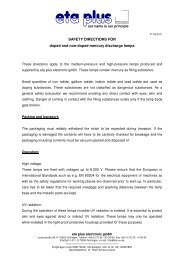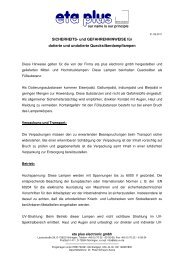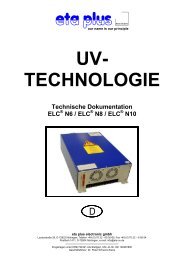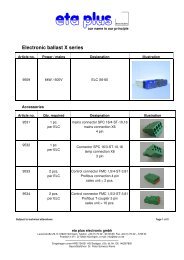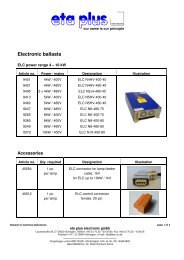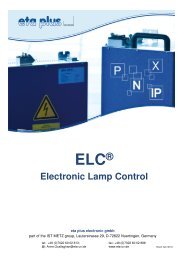UV- TECHNOLOGY Technical Documentation ELC PE22 / PE32
UV- TECHNOLOGY Technical Documentation ELC PE22 / PE32
UV- TECHNOLOGY Technical Documentation ELC PE22 / PE32
You also want an ePaper? Increase the reach of your titles
YUMPU automatically turns print PDFs into web optimized ePapers that Google loves.
���<br />
our name is our principle<br />
�<br />
<strong>UV</strong>-<br />
<strong>TECHNOLOGY</strong><br />
<strong>Technical</strong> <strong>Documentation</strong><br />
<strong>ELC</strong> <strong>PE22</strong> / <strong>PE32</strong><br />
eta plus electronic gmbh<br />
Lauterstraße 29, D-72622 Nürtingen, Telefon +49 (0) 70 22 - 60 02-80, Fax +49 (0) 70 22 – 6 58 54<br />
Postfach 1411, D-72604 Nürtingen, e-mail: info@eta-uv.de<br />
––––––––––––––––––––––––––––<br />
Eingetragen unter HRB 724321 AG Stuttgart, USt.-Id.-Nr. DE 146267800<br />
Geschäftsführer: Dr. Peter Schwarz-Kiene
<strong>ELC</strong> ® („Electronic Lamp Control“) is a registered trademark of<br />
IST Metz GmbH.<br />
<strong>ELC</strong> <strong>PE22</strong>_<strong>PE32</strong>-V2.2-09.11-GB Subject to technical alterations
Contents page I<br />
Contents<br />
1 Safety ................................................................................................. 1<br />
1.1 Definition of Symbols.................................................................................1<br />
1.2 Safety Advice ..............................................................................................1<br />
1.3 Correct operation........................................................................................2<br />
1.4 Extended use ..............................................................................................2<br />
2 Description of functions................................................................... 3<br />
3 Installation......................................................................................... 4<br />
3.1 Mounting of casing.....................................................................................4<br />
3.1.1 Vertical installation position ............................................................................5<br />
3.1.2 Horizontal installation position ........................................................................6<br />
3.2 Connection ..................................................................................................7<br />
3.3 Control- and bus connections .................................................................11<br />
3.4 Comments on the safety functions of the <strong>ELC</strong> ......................................14<br />
3.4.1 Safety relay...................................................................................................14<br />
3.4.2 Initialisation signal.........................................................................................15<br />
3.5 Configuration ............................................................................................15<br />
3.5.1 Setting up the PROFIBUS address...............................................................16<br />
3.5.2 Checking the PROFIBUS connection ...........................................................17<br />
3.5.3 Setting lamp power via PROFIBUS ..............................................................18<br />
3.5.4 To read out <strong>ELC</strong> serial number and softwareversion....................................20<br />
4 Operation of <strong>ELC</strong> ............................................................................ 21<br />
4.1 Initial operation .........................................................................................21<br />
4.2 Switching on the <strong>ELC</strong>...............................................................................21<br />
4.3 Activating the safety circuits ...................................................................21<br />
4.4 Switching on the lamp..............................................................................21<br />
4.5 Dimming operation ...................................................................................23<br />
4.6 Standby operation ....................................................................................23<br />
4.7 Switching off the lamp..............................................................................23<br />
<strong>ELC</strong> <strong>PE22</strong>_<strong>PE32</strong>-V2.2-09.11-GB Subject to technical alterations
Contents page II<br />
5 Monitoring, warning, error, repair ................................................. 24<br />
5.1 Earth fault control.....................................................................................24<br />
5.2 Warning messages ...................................................................................25<br />
5.3 Error...........................................................................................................27<br />
5.3.1 Error messages ............................................................................................27<br />
5.3.2 Troubleshooting ............................................................................................28<br />
5.3.3 Resetting the error register ...........................................................................29<br />
5.4 Repair <strong>ELC</strong> ................................................................................................29<br />
6 <strong>Technical</strong> Data................................................................................. 30<br />
<strong>ELC</strong> <strong>PE22</strong>_<strong>PE32</strong>-V2.2-09.11-GB Subject to technical alterations
1 Safety page 1<br />
1 Safety<br />
1.1 Definition of Symbols<br />
�<br />
Stop (Stop Danger). This symbol warns of serious danger of severe injury to<br />
persons. It must be strictly observed.<br />
Attention (Warning). This symbol indicates information the non-observance of<br />
which can lead to extensive damage to property. The safety warning must be<br />
strictly observed.<br />
Information. This symbol indicates key information on use. Non-observance can<br />
lead to failure.<br />
1.2 Safety Advice<br />
The <strong>ELC</strong> must be installed and connected in compliance with existing<br />
regulations and practices. This is e.g. EN 60204-1 in Europe.<br />
Repairs on the <strong>ELC</strong> may only be carried out by the manufacturer.<br />
The installation and starting up may only be carried out by skilled electricians.<br />
Do not open the <strong>ELC</strong> before it is disconnected from the mains. BEWARE OF<br />
RESIDUAL VOLTAGE! The unit may still be live up to three minutes after it has<br />
been switched off.<br />
<strong>ELC</strong> <strong>PE22</strong>_<strong>PE32</strong>-V2.2-09.11-GB Subject to technical alterations
1 Safety page 2<br />
The <strong>ELC</strong> causes a leakage current greater than 3.5 mA!<br />
Safeguarding by means of leakage current protection type A and type AC<br />
according to IEC 60755 is not permitted!<br />
The <strong>ELC</strong> operates in principle as a frequency converter and is equipped with a<br />
mains filter whose leakage current could activate fuse protection.<br />
Contact to the grounding connector must always be ensured.<br />
Additional measures must be taken to ensure that there is no danger when<br />
touching the appliance. This could be by means of a universal leakage current<br />
protection type B, taking into consideration the increased response threshold, or<br />
by means of an independent equipotential connection.<br />
1.3 Correct operation<br />
The <strong>ELC</strong> is an electrical unit intended to be installed in the switch cabinets of<br />
industrial high-voltage power installations. It is conceived as an electronic ballast<br />
for the operation of lamps intended for this purpose.<br />
Any other use is deemed as misuse. The manufacturer will not assume liability<br />
for damage resulting from misuse.<br />
A pre-requisite for authorised operation of the <strong>ELC</strong> is the observance of both the<br />
operating and maintenance instructions and the safety advice.<br />
1.4 Extended use<br />
Extended use beyond the operating specifications as stated is not permitted.<br />
The manufacturer will not assume liability if the equipment is used in any other<br />
way. The operator acts at his own risk.<br />
Any operation beyond the scope of the authorised operation is considered to be<br />
misuse.<br />
<strong>ELC</strong> <strong>PE22</strong>_<strong>PE32</strong>-V2.2-09.11-GB Subject to technical alterations
2 Description of functions page 3<br />
2 Description of functions<br />
The <strong>ELC</strong> is an electronic power supply unit for the operation of gas discharge lamps with<br />
electrical properties as described in chapter 6.<br />
In contrast to conventional ballasts (inductive lamp ballast or transformer or transformer with<br />
transductor), the lamp with an electronic ballast is operated with high frequency (approx.<br />
100 kHz). The lamp does not flicker and dimming is infinitely adjustable to a range between<br />
20 % and 100 % of the electric power or to between 15 % and 100 % of the <strong>UV</strong> radiation<br />
respectively.<br />
Dimming<br />
The possibility of dimming the lamp has two advantages. Firstly the lamp can be switched to<br />
minimum load (standby operation) during longer idle times and energy can thus be saved.<br />
Secondly the optimum lamp power can be determined and adjusted as appropriate.<br />
Power control<br />
The <strong>ELC</strong> offers a high level of lamp power constancy due to its integrated power control.<br />
Variations in operating voltage of ± 10 % do not affect lamp power.<br />
Ignition device<br />
When the lamp is switched on the <strong>ELC</strong> initiates trigger pulses to fire the lamp; a separate<br />
ignition device is not required.<br />
Other performance characteristics<br />
• High level of electrical efficiency.<br />
• Configuration, control and monitoring of the <strong>ELC</strong> is carried out via PROFIBUS-interface.<br />
• The <strong>ELC</strong> monitors the lamp cables for earth fault.<br />
• The lamp output potential is separated from that of the supply voltage.<br />
• The <strong>ELC</strong> is both short-circuit proof and safe in open circuit operation at the lamp output.<br />
<strong>ELC</strong> <strong>PE22</strong>_<strong>PE32</strong>-V2.2-09.11-GB Subject to technical alterations
3 Installation page 4<br />
3 Installation<br />
3.1 Mounting of casing<br />
The <strong>ELC</strong> must be installed in a control cabinet with at least IP 54 protection (see<br />
EN 60529). Operation without a control cabinet or in a control cabinet with a<br />
lower degree of protection is not permitted.<br />
It is only permitted to install the appliance in the positions described in 3.1.1 or<br />
3.1.2. When installed vertically, as described in Fig. 1, the control connections<br />
must be positioned at the bottom and supply connections at the top. Installation<br />
must allow for the minimum spacing.<br />
The <strong>ELC</strong> should not be mounted in the immediate proximity of sensitive<br />
electronic equipment. An appropriate distance must be maintained to scatter<br />
field transformers or other inductors.<br />
The flow of cool air for the <strong>ELC</strong> must be safeguarded. The ambient temperature<br />
must not exceed the values prescribed in chapter 6.<br />
Ventilation must be provided for the switch cabinet.<br />
The amount of air necessary is determined by the size and positioning of the<br />
switch cabinet, the total electrical losses and the external temperature. Please<br />
consult your switch cabinet manufacturer. For the recommended throughput of<br />
air please see the technical data in chapter 6.<br />
Impure cooling air could affect the functionality of the <strong>ELC</strong>. This can be avoided<br />
by installing a fine air filter.<br />
<strong>ELC</strong> <strong>PE22</strong>_<strong>PE32</strong>-V2.2-09.11-GB Subject to technical alterations
3 Installation page 5<br />
3.1.1 Vertical installation position<br />
Lufteintritt<br />
air entrance<br />
Lufteintritt<br />
air entrance<br />
Netzanschluß<br />
line input<br />
Lampenstecker<br />
lampconnection<br />
261 mm<br />
Steckerleiste für Steuersignale<br />
Oben<br />
top<br />
control connector<br />
<strong>ELC</strong> <strong>PE22</strong>_<strong>PE32</strong>-V2.2-09.11-GB Subject to technical alterations<br />
540 mm<br />
484 mm<br />
31 mm 200 mm<br />
31 mm<br />
Luftaustritt<br />
air exhaust<br />
Luftaustritt<br />
air exhaust<br />
Fig. 1: Assembly of the <strong>ELC</strong>, vertical installation position (all dimensions in mm).<br />
min. 150<br />
min. 150<br />
501 mm<br />
650 mm
3 Installation page 6<br />
3.1.2 Horizontal installation position<br />
Lufteintritt<br />
air entrance<br />
Lufteintritt<br />
air entrance<br />
261 mm<br />
Steckerleiste für Steuersignale<br />
control connector<br />
484 mm<br />
<strong>ELC</strong> <strong>PE22</strong>_<strong>PE32</strong>-V2.2-09.11-GB Subject to technical alterations<br />
min. 150<br />
650 mm<br />
501 mm<br />
Fig. 2: Assembly of the <strong>ELC</strong>, horizontal installation position (all dimensions in mm).<br />
min. 150
3 Installation page 7<br />
3.2 Connection<br />
L1<br />
L2<br />
L3<br />
N<br />
PE<br />
L1 L2 L3<br />
EVG<br />
out1 out2<br />
lamp assembly<br />
earthed lead network side<br />
automatic cutout<br />
power choke<br />
cable shield<br />
lamp feeder cable<br />
Fig. 3: Power connection <strong>PE22</strong> / <strong>PE32</strong><br />
Mains connection<br />
Fig. 4: Mains <strong>PE22</strong><br />
� <strong>PE22</strong>:<br />
<strong>ELC</strong> <strong>PE22</strong>_<strong>PE32</strong>-V2.2-09.11-GB Subject to technical alterations<br />
Fig. 3 shows the electrical installation.<br />
Operation of the ballasts requires a power<br />
choke in series (see technical data chapter<br />
6) in order to limit the total harmonic<br />
distortion of the line current to below 50%.<br />
The lamp feeder cable shielding must be<br />
connected to the <strong>ELC</strong>. To this end the<br />
connector has an EMC screw connection<br />
(also see: connection lamp cable).<br />
If wished, the shielding can also be<br />
connected to the lamp unit.<br />
The connection of mains supply cables and lamp feeder cables must be<br />
separated from control cables.<br />
Fig. 5: Mains <strong>PE32</strong><br />
The cross section of the<br />
earthed wire must be at least<br />
10 mm².<br />
The three phases must be<br />
provided with an automatic<br />
cutout.<br />
In order to avoid damaging the terminal pins, please do not exceed the following<br />
torque:<br />
L1, L2, L3: 1,5 – 1,8 Nm<br />
Grounding conductor: 3,0 – 4,0 Nm<br />
<strong>PE32</strong>:<br />
L1, L2, L3: 1,5 – 1,8 Nm<br />
Grounding conductor: 1,5 – 1,8 Nm
3 Installation page 8<br />
Connecting the lamp feeder cable<br />
�<br />
The lamp feeder cable must correspond with the cable parameters described in<br />
chapter 6.<br />
<strong>ELC</strong> <strong>PE22</strong>_<strong>PE32</strong>-V2.2-09.11-GB Subject to technical alterations<br />
Components of the connector:<br />
connector module<br />
crimp contacts<br />
hood<br />
EMC cable gland with<br />
plastic insert<br />
Preparing the lamp feeder cable:<br />
• Remove sheath<br />
• Free metal braid and put over cable<br />
sheath<br />
• Insulate conductor<br />
7,5<br />
100 12<br />
(measurements in mm)<br />
A suitable contact crimping tool is required of<br />
the type:<br />
Amphenol group C146<br />
Part No.: VN01 025 0029 1C<br />
Closed crimp barrels (individual contacts)<br />
2.5mm
3 Installation page 9<br />
<strong>ELC</strong> <strong>PE22</strong>_<strong>PE32</strong>-V2.2-09.11-GB Subject to technical alterations<br />
Top: Correct crimp connection<br />
Middle: Stripped part of the wire too long,<br />
gap between insulation and crimp barrel too<br />
large<br />
Bottom: Stripped part of the wire too short<br />
because conductor is not visible through<br />
inspection hole.<br />
• Insert cable into the cable gland and<br />
bush casing<br />
• Insert crimp contacts into the connector<br />
module until they lock into place<br />
• Ensure that the shield evenly covers the<br />
plastic inset of the cable gland (360°<br />
contact)<br />
• Tighten EMC cable gland
3 Installation page 10<br />
<strong>ELC</strong> <strong>PE22</strong>_<strong>PE32</strong>-V2.2-09.11-GB Subject to technical alterations<br />
• Screw the module into the hood casing.<br />
The picture on the left shows the<br />
recommended orientation.<br />
The lamp feeder cable between the switch cabinet and lamp assembly must be laid<br />
protected. For the correct installation of the lamp assembly and lamp please observe the<br />
corresponding manufacturer’s instructions.
3 Installation page 11<br />
3.3 Control- and bus connections<br />
Fig. 6 Control and bus connections<br />
Fig. 7 Coding control plug<br />
All control circuits must be earthed upon installation.<br />
<strong>ELC</strong> <strong>PE22</strong>_<strong>PE32</strong>-V2.2-09.11-GB Subject to technical alterations<br />
The control and bus cables are connected to the<br />
underside of the casing (see Fig. 6) by means of the<br />
plug connections available as accessories.<br />
In order to minimise the danger of mixing up the control<br />
connectors, the sockets on the appliance have been<br />
coded with the red code profiles. They are positioned<br />
according to the following picture:<br />
When the control connectors are delivered they are not<br />
coded and cannot be connected in this condition! In<br />
order to code the control connector the corresponding<br />
code “nose” must be removed (see Fig. 7). Pin 1 is<br />
marked by means of a stamping:
3 Installation page 12<br />
Overview pin assignment<br />
The connector pin assignment is shown in Fig. 8 and will be explained in the following tables.<br />
X1.1 X1.2 X1.3 X3.1 X3.2 X3.3 X3.4<br />
INIT<br />
PIN<br />
SAFETY<br />
CONT1<br />
INIT<br />
GND<br />
SAFETY<br />
REL<br />
BUS<br />
VCC<br />
<strong>ELC</strong> <strong>PE22</strong>_<strong>PE32</strong>-V2.2-09.11-GB Subject to technical alterations<br />
BUS B BUS A BUS<br />
GND<br />
SAFETY PROFIBUS<br />
SAFETY<br />
CONT2<br />
SAFETY<br />
GND<br />
BUS<br />
VCC<br />
BUS B BUS A BUS<br />
GND<br />
X2.1 X2.2 X2.3 X4.1 X4.2 X4.3 X4.4<br />
Fig. 8 Connector strip for <strong>ELC</strong> control<br />
Pin assignment of initialisation signal<br />
Designation Number Description technical<br />
INIT PIN X1.1 Input initialisation signal for<br />
safety shutdown +24Vext.<br />
24V DC ± 10% external<br />
supply<br />
INIT GND X1.2 GND Reference potential for X1.1<br />
Pin assignment of safety relay<br />
Designation Number Description technical<br />
SAFETY REL X1.3 Control signal input safety relay<br />
+24V DC<br />
Control pulse (+24V DC ±<br />
10% / 35mA) for the safety<br />
relay in reference to X2.3<br />
(GND)<br />
SAFETY CONT1 X2.1 Feedback contact 1 safety relay NCC 24V / 4A<br />
SAFETY CONT2 X2.2 Feedback contact 2 safety relay NCC 24V / 4A<br />
SAFETY GND X2.3 GND Reference potential for X1.3<br />
(safety relay)
3 Installation page 13<br />
Pin assignment of PROFIBUS<br />
Designation Number Description technical<br />
BUS VCC X3.1 external supply voltage 5V<br />
isolated for PROFIBUS<br />
BUS B X3.2 Data line PROFIBUS B Bus signal B<br />
BUS A X3.3 Data line PROFIBUS A Bus signal A<br />
<strong>ELC</strong> <strong>PE22</strong>_<strong>PE32</strong>-V2.2-09.11-GB Subject to technical alterations<br />
+5V DC isolated, output for<br />
terminator<br />
BUS GND X3.4 GND isolated for PROFIBUS Shield connection PROFIBUS<br />
BUS VCC X4.1 external supply voltage 5V<br />
isolated for PROFIBUS<br />
BUS B X4.2 Data line PROFIBUS B Bus signal B<br />
BUS A X4.3 Data line PROFIBUS A Bus signal A<br />
+5V DC isolated, output for<br />
terminator<br />
BUS GND X4.4 GND isolated for PROFIBUS Shield connection PROFIBUS<br />
The PROFIBUS contacts of X3 and X4 are internally connected. According to requirements<br />
apply a terminator in compliance with PROFIBUS-Norm IEC 61158:<br />
Fig. 9: Termination of PROFIBUS
3 Installation page 14<br />
3.4 Comments on the safety functions of the <strong>ELC</strong><br />
Fig. 10: Safety circuits of the <strong>ELC</strong><br />
3.4.1 Safety relay<br />
<strong>ELC</strong> <strong>PE22</strong>_<strong>PE32</strong>-V2.2-09.11-GB Subject to technical alterations<br />
<strong>ELC</strong> with PROFIBUS feature<br />
two safety circuits, as shown<br />
schematically in Fig. 10:<br />
1. Safety relay K1 with<br />
feedback via the normally<br />
closed contact (paragraph<br />
3.4.1)<br />
2. Monitoring of the<br />
initialisation signal<br />
(paragraph 3.4.2)<br />
To set the <strong>ELC</strong> ready for operation, the safety relay K1 has to be activated by applying +24V<br />
to pin X1.3 and GND on pin X2.3.<br />
As long as the safety relay is not activated, lamp operation is not possible! There are two<br />
feedback paths:<br />
• a normally closed relay contact. It may be tapped on pins X2.1 and X2.2.<br />
• the [Warning Register] of the PROFIBUS-input-data (see below and paragraph 5.2:<br />
Bit 4 {Safety Relay Open})<br />
If the safety relay is deactivated during lamp operation, lamp operation will be shut down.<br />
After reactivating the safety relay, the lamp has to be restarted.
3 Installation page 15<br />
3.4.2 Initialisation signal<br />
Furthermore lamp operation will not be allowed unless +24V are applied to pin X1.1 and<br />
GND on pin X1.2. This is an additional monitoring function for the safe operation of the<br />
installation. The status of pin X1.1 is visualized in the [Warning Register] of the PROFIBUSinput-data<br />
(see below and paragraph 5.2: Bit 7 {Init Signal Ok}).<br />
If the initialisation signal is deactivated during lamp operation, lamp operation will be shut<br />
down. After re-applying the initialisation signal, the lamp has to be restarted.<br />
3.5 Configuration<br />
Communication between <strong>ELC</strong> and installation control is carried out via PROFIBUS DPV0.<br />
The <strong>ELC</strong> represents a non-modular DPV0-Slave, the installation control functions as the<br />
Master.<br />
For configuration, control and monitoring of the <strong>ELC</strong> 16 input registers (Master receiving data<br />
from <strong>ELC</strong>) were implemented, as well as 6 output registers (Master sending data to <strong>ELC</strong>).<br />
For registers overlapping more than one byte, the byte order was determined according to<br />
”Big-Endian“.<br />
The preset baud rate is recognized automatically by the <strong>ELC</strong>. Software supports all baud<br />
rates from 9.6kBit to12MBit; tested values can be taken from the technical data in chapter 6<br />
(limitations may be caused by the connector).<br />
The necessary adjustments during the installing of the <strong>ELC</strong> will be explained in this<br />
paragraph, the adjustments for lamp operation will follow in chapter 4.<br />
PROFIBUS-input-data (<strong>ELC</strong> → Master)<br />
Byte-<br />
Nr.<br />
0 1 2 3 4 5 6 7 8 9 10 11 12 13 14 15<br />
Name [<strong>ELC</strong><br />
Serial<br />
Number]<br />
[Software<br />
Version]<br />
[<strong>ELC</strong><br />
Nominal<br />
Power]<br />
<strong>ELC</strong> <strong>PE22</strong>_<strong>PE32</strong>-V2.2-09.11-GB Subject to technical alterations<br />
[Error<br />
Register]<br />
PROFIBUS-output-data (Master → <strong>ELC</strong>)<br />
Byte-<br />
Nr.<br />
Name [Power<br />
Set<br />
Value]<br />
0 1 2 3 4 5<br />
[Installed<br />
Lamp<br />
Power]<br />
[Lamp<br />
Control]<br />
[Reserved]<br />
[Warning<br />
Register]<br />
[Lamp<br />
Status]<br />
[Actual<br />
Power]<br />
[Actual<br />
Voltage]<br />
[Actual<br />
Current]<br />
[Reserved]
3 Installation page 16<br />
3.5.1 Setting up the PROFIBUS address<br />
Fig. 11: LED status (red left, green right) and rotary coding switch for low and high nibble<br />
The PROFIBUS address must be set using the rotary coding switches.<br />
The address space extends from 01hex to 7Dhex (corresponding to 1 to 125), whereby low and<br />
high nibble are allocated according to Fig. 11. Each address may be used only once per<br />
installation.<br />
The address is adopted when current is applied to the <strong>ELC</strong> (paragraph 4.2). If the appliance<br />
is already under power supply, it must first be disconnected.<br />
<strong>ELC</strong> <strong>PE22</strong>_<strong>PE32</strong>-V2.2-09.11-GB Subject to technical alterations
3 Installation page 17<br />
3.5.2 Checking the PROFIBUS connection<br />
The Status-LED (Fig. 11) may be used to check the successful connection of <strong>ELC</strong> and<br />
Master and furthermore the existence of an error (<strong>ELC</strong> not ready for operation):<br />
LED red<br />
(left)<br />
LED green<br />
(right)<br />
<strong>ELC</strong> <strong>PE22</strong>_<strong>PE32</strong>-V2.2-09.11-GB Subject to technical alterations<br />
Status Corrective action<br />
off on <strong>ELC</strong> ready for operation,<br />
PROFIBUS-connection ok<br />
off blinking <strong>ELC</strong> ready for operation, no<br />
PROFIBUS-connection<br />
blinking on <strong>ELC</strong> not ready for<br />
operation, PROFIBUSconnection<br />
ok<br />
blinking blinking <strong>ELC</strong> not ready for<br />
operation, no PROFIBUSconnection<br />
Check plug contact, bus<br />
termination (see paragraph 3.3),<br />
check address and panelprogramming.<br />
The error cause detected by the<br />
<strong>ELC</strong> may be read out in the Error<br />
Register (see paragraph 5.3.1)<br />
Detach <strong>ELC</strong> from mains and<br />
restart.<br />
blinking off Internal error. Detach <strong>ELC</strong> from mains and<br />
restart.<br />
off off Internal error or no supply. Check power supply
3 Installation page 18<br />
3.5.3 Setting lamp power via PROFIBUS<br />
PROFIBUS-output-data (Master → <strong>ELC</strong>)<br />
Byte-<br />
Nr.<br />
0 1 2 3 4 5<br />
Name [Power<br />
Set<br />
Value]<br />
[Installed<br />
Lamp<br />
Power]<br />
[Lamp<br />
Control]<br />
<strong>ELC</strong> <strong>PE22</strong>_<strong>PE32</strong>-V2.2-09.11-GB Subject to technical alterations<br />
[Reserved]<br />
The set value for lamp power has to be written into the register [Power Set Value]. The<br />
<strong>ELC</strong>’s output power is defined by the control characteristic of Fig. 12.<br />
Lamp power<br />
<strong>ELC</strong>-nominalpower<br />
20% <strong>ELC</strong>-nominal-power<br />
Fig. 12: Control characteristic<br />
20% <strong>ELC</strong>-nominal-power <strong>ELC</strong>-nominalpower<br />
The lamp power can be set in steps of 32 W.<br />
[Power Set<br />
Value]<br />
The <strong>ELC</strong>’s nominal power is written into the register [<strong>ELC</strong> Nominal Power] of the<br />
PROFIBUS-input-data:<br />
PROFIBUS-input-data (<strong>ELC</strong> → Master)<br />
Byte-<br />
Nr.<br />
0 1 2 3 4 5 6 7 8 9 10 11 12 13 14 15<br />
Name [<strong>ELC</strong><br />
Serial<br />
Number]<br />
[Software<br />
Version]<br />
[<strong>ELC</strong><br />
Nominal<br />
Power]<br />
[Error<br />
Register]<br />
[Warning<br />
Register]<br />
[Lamp<br />
Status]<br />
[Actual<br />
Power]<br />
[Actual<br />
Voltage]<br />
[Actual<br />
Current]<br />
[Reserved]
3 Installation page 19<br />
PROFIBUS-output-data (Master → <strong>ELC</strong>)<br />
Byte-<br />
Nr.<br />
Name [Power<br />
Set<br />
Value]<br />
0 1 2 3 4 5<br />
[Installed<br />
Lamp<br />
Power]<br />
[Lamp<br />
Control]<br />
<strong>ELC</strong> <strong>PE22</strong>_<strong>PE32</strong>-V2.2-09.11-GB Subject to technical alterations<br />
[Reserved]<br />
To limit the maximum output power, use the register [Installed Lamp Power] (see Fig. 13).<br />
This function is appropriate if the nominal power of the lamp is lower than the nominal power<br />
of the <strong>ELC</strong>.<br />
Lamp power<br />
<strong>ELC</strong>-nominalpower<br />
[Installed Lamp<br />
Power]<br />
20% <strong>ELC</strong>-nominal-power<br />
Fig. 13: Limited output power characteristic<br />
�<br />
20% <strong>ELC</strong>-nominal-power Installed lamp<br />
power<br />
<strong>ELC</strong>-nominalpower<br />
Sollleistungs-<br />
[Power<br />
vorgabe<br />
[Power<br />
vorgabe<br />
Set<br />
Value]<br />
[Power<br />
Value]<br />
[Power Set<br />
Value]<br />
The control characteristic of Fig. 12 comes into effect, if the register [Installed<br />
Lamp Power] is<br />
• not set<br />
• below 20% of <strong>ELC</strong> nominal power<br />
• above <strong>ELC</strong> nominal power
3 Installation page 20<br />
3.5.4 To read out <strong>ELC</strong> serial number and softwareversion<br />
These data may be accessed via display or PROFIBUS and may be of interest e.g. for<br />
service and in case of a defect.<br />
PROFIBUS-input-data (<strong>ELC</strong> → Master)<br />
Byte-<br />
Nr.<br />
0 1 2 3 4 5 6 7 8 9 10 11 12 13 14 15<br />
Name [<strong>ELC</strong><br />
Serial<br />
Number]<br />
↓<br />
[Software<br />
Version]<br />
[<strong>ELC</strong><br />
Nominal<br />
Power]<br />
<strong>ELC</strong> <strong>PE22</strong>_<strong>PE32</strong>-V2.2-09.11-GB Subject to technical alterations<br />
[Error<br />
Register]<br />
[Warning<br />
Register]<br />
[Lamp<br />
Status]<br />
[Actual<br />
Power]<br />
Byte 2 Byte 1 Byte 0<br />
[Actual<br />
Voltage]<br />
[Actual<br />
Current]<br />
7 6 5 4 3 2 1 0 7 6 5 4 3 2 1 0 7 6 5 4 3 2 1 0<br />
consecutive number<br />
month year<br />
[<strong>ELC</strong> Serial Number] is indicated by the first three registers. The exact division of the bits<br />
into year, month and consecutive number is defined by the brackets.<br />
Example: 01F30516 stands for: consecutive number = 62, month = 6 and year = 5.<br />
[Software Version] contains the currently installed software version. The high nibble<br />
represents the main version (e.g. 10), the low-nibble the secondary version (e.g. 2).<br />
Accordingly the example Version 10.2 is written as A216.<br />
[Reserved]
4 Operation of <strong>ELC</strong> page 21<br />
4 Operation of <strong>ELC</strong><br />
4.1 Initial operation<br />
• The operative parameters of the <strong>ELC</strong>, such as the scope of the trigger pulse when<br />
switching on the lamp, are set by the manufacturer.<br />
• You must always ensure that the correct lamp type is used (see chapter 6) and that all<br />
wireing is properly connected!<br />
4.2 Switching on the <strong>ELC</strong><br />
• The <strong>ELC</strong> is switched on by applying the operating voltage and the 24V supply.<br />
4.3 Activating the safety circuits<br />
• Activate the safety relay<br />
• Apply the initialisation signal<br />
4.4 Switching on the lamp<br />
PROFIBUS-output-data (Master → <strong>ELC</strong>)<br />
Byte-<br />
Nr.<br />
0 1 2 3 4 5<br />
Name [Power<br />
Set<br />
Value]<br />
[Installed<br />
Lamp<br />
Power]<br />
[Lamp<br />
Control]<br />
↓<br />
<strong>ELC</strong> <strong>PE22</strong>_<strong>PE32</strong>-V2.2-09.11-GB Subject to technical alterations<br />
[Reserved]<br />
Bit 7 6 5 4 3 2 1 0<br />
Name n/a n/a n/a n/a n/a n/a Clear<br />
Error<br />
Start<br />
Lamp<br />
• Before starting the lamp it is necessary to write the desired lamp power into the register<br />
[Power Set Value] in Watts. To transfer the lamp and its surrounding into a thermally<br />
stable condition, it is recommended to choose the maximum lamp power for [Power Set<br />
Value] during the lamp warm-up period.<br />
• To ignite the lamp set the {Start Lamp}-Bit in register [Lamp Control] to 1.<br />
• {n/a}: not available. These bits are reserved for future applications.
4 Operation of <strong>ELC</strong> page 22<br />
�<br />
�<br />
�<br />
Power must be applied to the <strong>ELC</strong> for at least 2 seconds before attempting to<br />
fire the lamp.<br />
In case of an error the <strong>ELC</strong> will not try to ignite the lamp. After eliminating the<br />
error the [Error Register] has to be cleared additionally (see paragraph 5.3).<br />
As long as the safety circuits are not activated the <strong>ELC</strong> will not try to ignite the<br />
lamp (see paragraph 5.2).<br />
During warm-up the lamp power stays at a very low level over a longer period of time and<br />
after approximately 60 seconds rapidly increases to its nominal power. The lamp is operated<br />
with increased current until the nominal power is reached. The actual condition of the lamp<br />
may be read out from register [Lamp Status] of the PROFIBUS-input-data:<br />
PROFIBUS-input-data (<strong>ELC</strong> → Master)<br />
Byte-<br />
Nr.<br />
0 1 2 3 4 5 6 7 8 9 10 11 12 13 14 15<br />
Name [<strong>ELC</strong><br />
Serial<br />
Number]<br />
[Software<br />
Version]<br />
[<strong>ELC</strong><br />
Nominal<br />
Power]<br />
Bits in use in register [Lamp Status]:<br />
<strong>ELC</strong> <strong>PE22</strong>_<strong>PE32</strong>-V2.2-09.11-GB Subject to technical alterations<br />
[Error<br />
Register]<br />
[Warning<br />
Register]<br />
[Lamp<br />
Status]<br />
↓<br />
[Actual<br />
Power]<br />
[Actual<br />
Voltage]<br />
[Actual<br />
Current]<br />
Bit 7 6 5 4 3 2 1 0<br />
Name n/a n/a n/a n/a n/a Lamp<br />
Ignition<br />
• Bit 2 {Lamp Ignition}: during the ignition phase of the lamp the ”ignition“ bit is set (value =<br />
1, otherwise 0).<br />
• Bit 1 {Run Up}: during warm-up of the lamp the “run-up“-bit is set (value = 1, otherwise 0).<br />
• Bit 0 {Lamp On}: as soon as the lamp has reached the required power and lamp voltage<br />
is in a steady state, the ”lamp-on“-bit will be set (value = 1, otherwise 0).<br />
Further operation data of the continuous operation state may be read out from the registers<br />
[Actual Power], [Actual Voltage] and [Actual Current]:<br />
• [Actual Power] returns the actual power in Watts.<br />
• [Actual Voltage] gives account of the actual lamp voltage in Volts.<br />
• [Actual Current] contains the actual current in Ampère*10 with an accuracy of 100 mA<br />
(e.g.: [Actual Current] = 12 means 1,2 A).<br />
Run<br />
Up<br />
[Reserved]<br />
Lamp<br />
On
4 Operation of <strong>ELC</strong> page 23<br />
4.5 Dimming operation<br />
After having reached nominal operation the desired lamp power can be infinitely adjusted.<br />
• Enter the desired power in Watts in register [Power Set Value].<br />
�<br />
A set value of less than 20% of the <strong>ELC</strong>-nominal-power will automatically be<br />
increased by the <strong>ELC</strong> to 20% of the <strong>ELC</strong> nominal- power.<br />
4.6 Standby operation<br />
During longer idle times the <strong>ELC</strong> can be switched to standby operation. The lamp is operated<br />
at minimum power but can be brought up to nominal power within a few seconds.<br />
• Standby operation corresponds to 20% of the <strong>ELC</strong> nominal power. This can be attained<br />
by setting the register [Power Set Value] at a value equal to or lower than 20% of <strong>ELC</strong><br />
nominal power.<br />
The warm-up time from standby operation to nominal operation depends on the lamp's<br />
ambient conditions. If cooling is too intensive during dimming operation, the acceleration time<br />
is prolonged.<br />
4.7 Switching off the lamp<br />
• The lamp is switched off by setting the {Start Lamp}-bit to 0 in register [Lamp Control].<br />
�<br />
In order to avoid heat accumulation in the <strong>ELC</strong> the power supply should be left<br />
on for a few minutes. Before restarting, the lamp must be sufficiently cooled<br />
down as it cannot be fired otherwise.<br />
<strong>ELC</strong> <strong>PE22</strong>_<strong>PE32</strong>-V2.2-09.11-GB Subject to technical alterations
5 Monitoring, warning, error, repair page 24<br />
5 Monitoring, warning, error, repair<br />
5.1 Earth fault control<br />
Supplementary to the safety functions of paragraph 3.4 which prevent danger to the<br />
operator, the earth fault control of the <strong>ELC</strong> lamp circuit represents another monitoring<br />
function.<br />
Lamp<br />
R_error<br />
Error Register<br />
PROFIBUS-connection<br />
Fig. 14: Earth fault monitoring<br />
Earth Fault Bit<br />
PROFIBUS input data (<strong>ELC</strong> → Master)<br />
Byte-<br />
Nr.<br />
<strong>ELC</strong> <strong>PE22</strong>_<strong>PE32</strong>-V2.2-09.11-GB Subject to technical alterations<br />
An earth fault occurs when the isolation resistance<br />
R_error (see Fig. 14) drops below approx. 200 kOhm.<br />
The <strong>ELC</strong> will shut down the lamp automatically in<br />
case of an earth fault.<br />
In order for the earth fault control to function properly<br />
it is essential that the <strong>ELC</strong> is connected as<br />
prescribed, particularly the earth connectors.<br />
An earth fault is reported by the {Earth Leakage<br />
Fault}-bit in the [Error Register] (in normal<br />
operation status the bit value is 0).<br />
Earth fault monitoring is also active if the lamp is not<br />
running. However the error message will only be<br />
effectuated when trying to start the lamp.<br />
0 1 2 3 4 5 6 7 8 9 10 11 12 13 14 15<br />
Name [<strong>ELC</strong><br />
Serial<br />
Number]<br />
[Software<br />
Version]<br />
[<strong>ELC</strong><br />
Nominal<br />
Power]<br />
[Error<br />
Register]<br />
Byte 6<br />
↓<br />
[Warning<br />
Register]<br />
[Lamp<br />
Status]<br />
[Actual<br />
Power]<br />
[Actual<br />
Voltage]<br />
Bit 15 14 13 12 11 10 9 8<br />
Name n/a n/a Lamp<br />
Power<br />
Low<br />
internal internal Earth<br />
Leakage<br />
Fault<br />
[Actual<br />
Current]<br />
internal internal<br />
[Reserved]
5 Monitoring, warning, error, repair page 25<br />
Byte 7<br />
Bit 7 6 5 4 3 2 1 0<br />
Name Lamp<br />
Voltage<br />
High<br />
�<br />
internal Bus<br />
Connection<br />
Error<br />
<strong>ELC</strong> <strong>PE22</strong>_<strong>PE32</strong>-V2.2-09.11-GB Subject to technical alterations<br />
internal <strong>ELC</strong><br />
Temperature<br />
High<br />
internal Main<br />
Voltage<br />
Low<br />
internal<br />
In order to avoid an unwanted reaction of the earth fault control during faultless<br />
operation, the isolation resistance of the lamp cables and all lamp connectors<br />
must be greater than 10 MΩ.<br />
5.2 Warning messages<br />
The bits in the [Warning Register] are divided into two groups:<br />
• Group1-Nibble: the bits 0-3 represent critical operating conditions of the lamp. However<br />
they won’t shut down the lamp.<br />
• Group2-Nibble: If a bit in the Group2-nibble (bits 4-7) is set, the lamp cannot be started<br />
or will be shut down during operation.<br />
The bits of the [Warning Register] will automatically be reset as soon as the triggering status<br />
has been resolved.<br />
PROFIBUS-input-data (<strong>ELC</strong> → Master)<br />
Byte-<br />
Nr.<br />
0 1 2 3 4 5 6 7 8 9 10 11 12 13 14 15<br />
Name [<strong>ELC</strong><br />
Serial<br />
Number]<br />
[Software<br />
Version]<br />
[<strong>ELC</strong><br />
Nominal<br />
Power]<br />
[Error<br />
Register]<br />
[Warning<br />
Register]<br />
↓<br />
[Lamp<br />
Status]<br />
[Actual<br />
Power]<br />
[Actual<br />
Voltage]<br />
[Actual<br />
Current]<br />
Bit 7 6 5 4 3 2 1 0<br />
Name Init<br />
Signal<br />
Ok<br />
n/a Lamp<br />
Ignition<br />
Failed<br />
Safety<br />
Relay<br />
Open<br />
Group 2:<br />
Lamp operation not<br />
possible<br />
n/a n/a Run<br />
Up<br />
Long<br />
Group 1:<br />
No shut<br />
down<br />
[Reserved]<br />
Lamp<br />
Voltage<br />
Low
5 Monitoring, warning, error, repair page 26<br />
Bit 0: The {Lamp Voltage Low}-bit is set if the burning voltage of the lamp falls<br />
below its minimum (set by the manufacturer). This bit will be reset if the lamp<br />
voltage exceeds the minimum.<br />
Bit 1: The {Run Up Long}-bit is set if the warm up of the lamp takes longer than<br />
expected. Reset occurs as soon as the {Start Lamp}-bit in register [Lamp<br />
Control] is set to 0 (the lamp being thus actively shut down by the operator<br />
via the PROFIBUS output data).<br />
Bit 4: The {Safety Relay Open} bit is set if the safety relay is not closed (e.g. on<br />
emergency shutdown). There are two different cases:<br />
• If in register [Lamp Control] {Start Lamp} bit is 0, the {Safety Relay<br />
Open} bit is automatically reset as soon as the safety relay is closed.<br />
• During lamp operation ({Start Lamp}=1 in [Lamp Control]) the {Safety<br />
Relay Open} bit remains set and the lamp will be shut down by the <strong>ELC</strong>.<br />
In this case {Safety Relay Open} will only be reset if {Start Lamp} in<br />
[Lamp Control] is reset and the safety relay has been closed.<br />
Bit 5: If the <strong>ELC</strong> cannot ignite the lamp the {Lamp Ignition Failed} bit will be set<br />
and remains in this status as long as {Start Lamp}=1 in [Lamp Control]. The<br />
{Lamp Ignition Failed} bit is reset as soon as {Start Lamp} in [Lamp<br />
Control] is reset.<br />
Bit 7: The {Init Signal Ok} bit reflects the status of the Init-Pin X1.1 of the<br />
initialisation signal (see paragraph 3.4.2).<br />
• {Init Signal Ok}=1 means 24 V on X1.1, the lamp may be ignited and<br />
operated normally.<br />
• {Init Signal Ok}=0 means 0 V on X1.1, the lamp cannot be operated.<br />
To render the <strong>ELC</strong> operational again in case {Init Signal Ok}=0 the<br />
initialisation signal on X1.1 has to be 24V and the start signal {Start Lamp}<br />
has to be reset.<br />
Bit 2, Bit 3 und Bit 6: {n/a} bits (not available) are reserved for future applications.<br />
<strong>ELC</strong> <strong>PE22</strong>_<strong>PE32</strong>-V2.2-09.11-GB Subject to technical alterations
5 Monitoring, warning, error, repair page 27<br />
5.3 Error<br />
5.3.1 Error messages<br />
Effects of an error:<br />
• The lamp will be immediately shut down,<br />
• In case of an error the red Status-LED is blinking (s. Fig. 11),<br />
• Bits in the [Error Register] will be set as soon as the correspondent error occurs.<br />
PROFIBUS-input-data (<strong>ELC</strong> → Master)<br />
Byte-<br />
Nr.<br />
0 1 2 3 4 5 6 7 8 9 10 11 12 13 14 15<br />
Name [<strong>ELC</strong><br />
Serial<br />
Number]<br />
[Software<br />
Version]<br />
[<strong>ELC</strong><br />
Nominal<br />
Power]<br />
<strong>ELC</strong> <strong>PE22</strong>_<strong>PE32</strong>-V2.2-09.11-GB Subject to technical alterations<br />
[Error<br />
Register]<br />
[Warning<br />
Register]<br />
Byte 6<br />
↓<br />
[Lamp<br />
Status]<br />
[Actual<br />
Power]<br />
[Actual<br />
Voltage]<br />
Bit 15 14 13 12 11 10 9 8<br />
Name n/a n/a Lamp<br />
Power<br />
Low<br />
Byte 7<br />
internal internal Earth<br />
Leakage<br />
Fault<br />
[Actual<br />
Current]<br />
internal internal<br />
Bit 7 6 5 4 3 2 1 0<br />
Name Lamp<br />
Voltage<br />
High<br />
internal Bus<br />
Connection<br />
Error<br />
internal <strong>ELC</strong><br />
Temperature<br />
High<br />
internal Main<br />
Voltage<br />
Low<br />
internal<br />
Bit 1: An error of the mains is recorded in the {Main Voltage Low}-bit if the mains<br />
voltage falls below the allowed minimum (see chapter 6) during lamp<br />
operation.<br />
Bit 3: The {<strong>ELC</strong> Temperature High} bit is set as soon as the acceptable<br />
temperature is exceeded.<br />
Bit 5: If the PROFIBUS connection is interrupted during lamp operation the {Bus<br />
Connection Error} bit is set. Additionally the green Status-LED (see Fig. 11)<br />
is blinking, or completely off as soon as the internal communication of the <strong>ELC</strong><br />
is interrupted.<br />
Bit 7: If the burning voltage of the lamp is too high the {Lamp Voltage High} bit is<br />
set.<br />
[Reserved]
5 Monitoring, warning, error, repair page 28<br />
Bit 10: The {Earth Leakage Fault}-bit is set if a leakage current to ground on Rerror<br />
(see paragraph 5.1) is detected.<br />
Bit 13: If the lamp extinguishes on its own during lamp operation, the {Lamp Power<br />
Low} bit is set.<br />
Bit 0, Bit 4, Bit 6, Bit 8, Bit 9, Bit 11, Bit 12: bits for analysis by the manufacturer..<br />
Bit 2, Bit 14 und Bit 15: {n/a} bits (not available) are reserved for future<br />
applications.<br />
5.3.2 Troubleshooting<br />
Troubles Possible causes Corrective action<br />
Bit 1: mains voltage too low mains voltage drop or<br />
fluctuations<br />
Bit 3: <strong>ELC</strong>-temperature too<br />
high<br />
Bit 5: No bus connection Bus termination faulty,<br />
loosend connector<br />
Bit 7: Burning voltage of the<br />
lamp too high<br />
Bit 10: Earth fault in lamp<br />
circuit<br />
Bit 13: Lamp extinguishes<br />
on its own<br />
<strong>ELC</strong> <strong>PE22</strong>_<strong>PE32</strong>-V2.2-09.11-GB Subject to technical alterations<br />
Check connections and mains<br />
voltage (if possible)<br />
Ambient temperature too high Check fans of cabinet<br />
(direction of air current, change<br />
filter mats)<br />
Check termination and<br />
connector<br />
Lamp type not correct Check lamp type and switch<br />
lamp<br />
Bad wiring on the lamp, high<br />
air humidity, polluted cables or<br />
connections<br />
Cooling too strong or lamp<br />
defect<br />
Check lamp wiring and<br />
isolation resistance (if<br />
possible)<br />
Reduce cooling or replace<br />
lamp
5 Monitoring, warning, error, repair page 29<br />
5.3.3 Resetting the error register<br />
Each error has to be acknowledged by setting the {Clear Error} bit in register [Lamp<br />
Control] to “1”. First of all set the {Start Lamp} bit in register [Lamp Control] to 0. Then<br />
only the transgression of the {Clear Error} bit from “0” to “1” can reset the [Error Register].<br />
After the PROFIBUS has transmitted the [Lamp Control] Register (check e.g. via the [Error<br />
Register]: if error eliminated all error bits are „0“ again) and after an <strong>ELC</strong> internal<br />
synchronisation time of additional 15 ms, the {Clear Error}-bit has to be reset to „0“.<br />
PROFIBUS-output-data (Master → <strong>ELC</strong>)<br />
Byte-<br />
Nr.<br />
Name [Power<br />
Set<br />
Value]<br />
0 1 2 3 4 5<br />
5.4 Repair <strong>ELC</strong><br />
[Installed<br />
Lamp<br />
Power]<br />
[Lamp<br />
Control]<br />
↓<br />
<strong>ELC</strong> <strong>PE22</strong>_<strong>PE32</strong>-V2.2-09.11-GB Subject to technical alterations<br />
[Reserved]<br />
Bit 7 6 5 4 3 2 1 0<br />
Name n/a n/a n/a n/a n/a n/a Clear<br />
Error<br />
Start<br />
Lamp<br />
Only the manufacturer is permitted to repair the <strong>ELC</strong>. In case of failure please contact the<br />
following address:<br />
eta plus electronic gmbh<br />
Lauterstraße 29<br />
D-72622 Nürtingen<br />
Tel: +49 7022 / 6002-80<br />
Fax: +49 7022 / 65854<br />
e-mail: Info@eta-uv.de
6 <strong>Technical</strong> Data page 30<br />
6 <strong>Technical</strong> Data<br />
General data <strong>ELC</strong><br />
Power choke Uk = 4%<br />
Power factor Typ. 0.88<br />
at Uk = 4% of the upstream power choke<br />
Power efficiency Typ. 0.94<br />
Mains frequency 50 / 60 Hz<br />
Tolerance mains voltage nominal voltage ± 10 %<br />
Recommended air throughput<br />
for cabinet ventilation<br />
<strong>ELC</strong> <strong>PE22</strong>_<strong>PE32</strong>-V2.2-09.11-GB Subject to technical alterations<br />
300 m 3 / h per <strong>ELC</strong> installed at ∆T = 10 K<br />
Control range approx. 20 - 100 %<br />
Firing voltage / duration < 3500 V / < 1 sec.<br />
Protection IP 20<br />
Permissible pollution pollution severity 2 according to VDE 0110<br />
Permissible humidity relative atmospheric humidity 80 %, non-condensing<br />
Dimensions (H x W x D) approx. 650 x 261 x 484 mm<br />
Installation position vertical (lamp and power connection at the top; control connections at the<br />
bottom) or horizontal respecting the minimum spacing in 3.1<br />
Baud rate Tested up to 500kBit<br />
EMC EN 55011<br />
EN 61000-3-3<br />
EN 61000-6-2<br />
Safety EN 50178<br />
Leakage current Leakage current > 3 mA, see chapter 1 “Safety“
6 <strong>Technical</strong> Data page 31<br />
Type specific data (nominal values)<br />
Typ <strong>ELC</strong><br />
<strong>PE22</strong>-400-210<br />
<strong>ELC</strong> <strong>PE22</strong>_<strong>PE32</strong>-V2.2-09.11-GB Subject to technical alterations<br />
<strong>ELC</strong><br />
<strong>PE32</strong>-400-280<br />
Power supply 3 x 400 V 3 x 400 V<br />
Supply current 38,2 A 57,0 A<br />
Max. supply current 42,6 A 62,6 A<br />
Weight approx. 29 kg approx. 37 kg<br />
Line protection * 50 A 63 A<br />
Max. ambient<br />
temperature<br />
in operation<br />
Max. ambient<br />
temperature<br />
during storage and<br />
transportation<br />
0°C bis +45°C 0°C bis +40°C<br />
-20°C bis +70°C -20°C bis +70°C<br />
before initial operation leave at<br />
least 4 hrs at room temperature<br />
Lamp output 22 kW 32 kW<br />
Lamp voltage 2100 V 2800 V<br />
Tolerance lamp voltage ± 5 % ± 5 %<br />
*Line protection: 3-channel automatic cut-out characteristic C<br />
Lamp feeder cable: approved types and lengths<br />
�<br />
The use of cable types which have not been approved by the manufacturer can<br />
lead to malfunction. The possibility of damage to the electronic ballast cannot be<br />
excluded.<br />
Article no. Type <strong>ELC</strong> <strong>PE22</strong>-400-210 <strong>ELC</strong> <strong>PE32</strong>-400-280<br />
8067<br />
Lamp feeder cable 4kV<br />
2x2.5 mm²<br />
external-Ø 13,5 mm<br />
5-40 m 5-40 m<br />
The data refers to distance between <strong>ELC</strong> and lamp.




